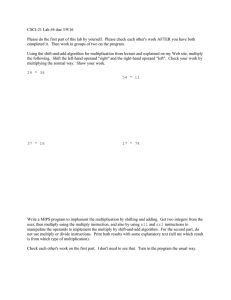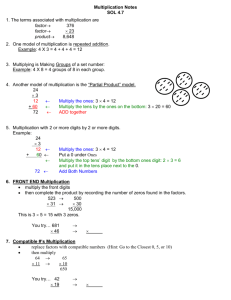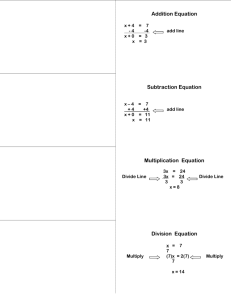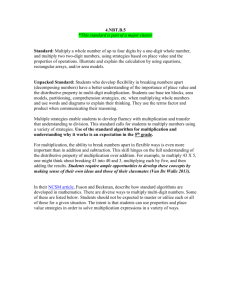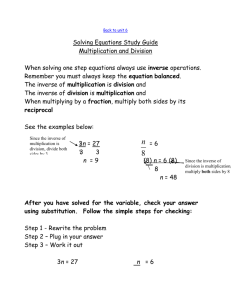Additional Notes on Multiplication and Division
advertisement
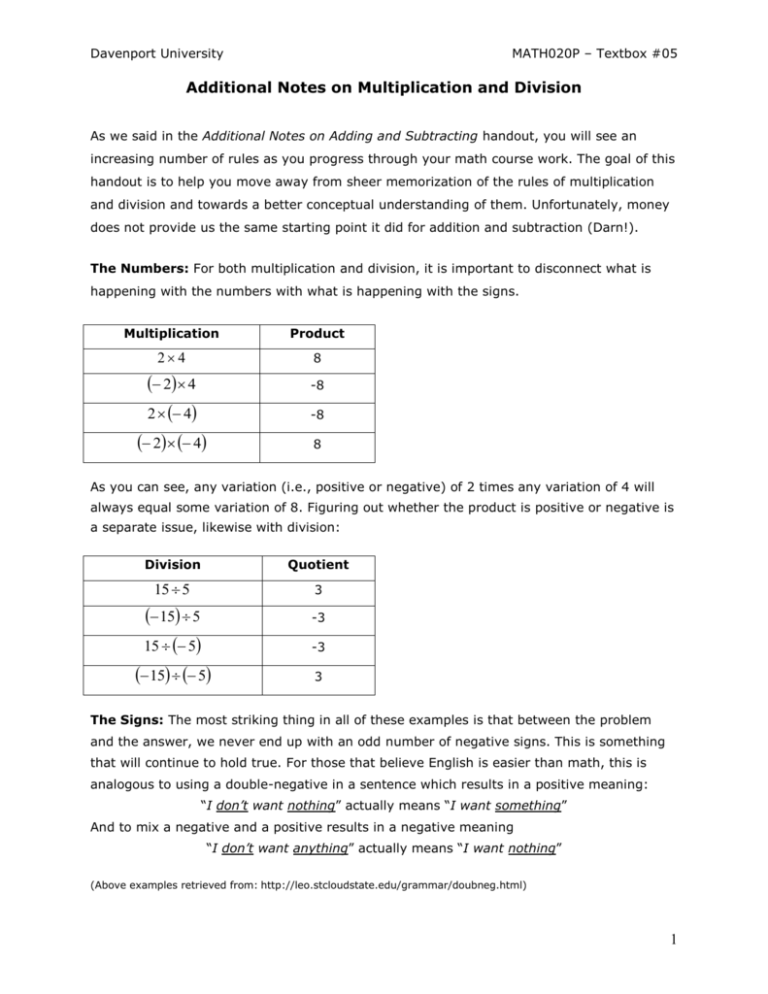
Davenport University MATH020P – Textbox #05 Additional Notes on Multiplication and Division As we said in the Additional Notes on Adding and Subtracting handout, you will see an increasing number of rules as you progress through your math course work. The goal of this handout is to help you move away from sheer memorization of the rules of multiplication and division and towards a better conceptual understanding of them. Unfortunately, money does not provide us the same starting point it did for addition and subtraction (Darn!). The Numbers: For both multiplication and division, it is important to disconnect what is happening with the numbers with what is happening with the signs. Multiplication Product 2 4 8 2 4 2 4 2 4 -8 -8 8 As you can see, any variation (i.e., positive or negative) of 2 times any variation of 4 will always equal some variation of 8. Figuring out whether the product is positive or negative is a separate issue, likewise with division: Division Quotient 15 5 3 15 5 15 5 15 5 -3 -3 3 The Signs: The most striking thing in all of these examples is that between the problem and the answer, we never end up with an odd number of negative signs. This is something that will continue to hold true. For those that believe English is easier than math, this is analogous to using a double-negative in a sentence which results in a positive meaning: “I don’t want nothing” actually means “I want something” And to mix a negative and a positive results in a negative meaning “I don’t want anything” actually means “I want nothing” (Above examples retrieved from: http://leo.stcloudstate.edu/grammar/doubneg.html) 1 Davenport University MATH020P – Textbox #05 And now, back to the math: Example 1: Multiply: 6 7 First off, 6 times 7 is 42. Because there is only one negative sign, our answer must be negative in order to finish with an even number of negative signs. Hence: Example 2: Multiply: 6 7 42 3 9 First off, 3 times 9 is 27. Because we already have an even number of negative signs, our answer must be positive. Hence: Example 3: Multiply: 3 9 27 3 2 4 First off, 3 times 2 is 6, and then 6 times 4 is 24. Because there are three negative signs, our answer must be negative in order to finish with an even number of negative signs. Hence: 3 2 4 24 Example 4: Multiply: 3 2 5 First off, 3 times 2 is 6, and then 6 times 5 is 30. Because we already have an even number of negative signs, our answer must be positive. Hence: Example 5: Divide: 3 2 4 30 40 8 First off, 40 divided by 8 is 5. Because we already have an even number of negative signs, our answer must be positive. Hence: Example 6: Divide: 40 8 5 66 11 First off, 66 divided by 11 is 6. Because there is only one negative sign, our answer must be negative in order to finish with an even number of negative signs. Hence: 66 11 6 Example 7: (Alas, an example using money!) Gary goes to the casino each day after work. The following are his winnings or losses for each day: 10, -20, -30, 10, and -25. Find his average daily result. To compute the average, add the numbers together: 10 + (-20) + (-30) + 10 + (-25) = -55 And then divide by the number of days: 55 5 First off, 55 divided by 5 is 11. Next, what does common sense tell you? Gary lost money for the week; is there any way that “on average” he won money each day? Of course not! Gary had to average a loss each day. Hence: 55 5 11 2

